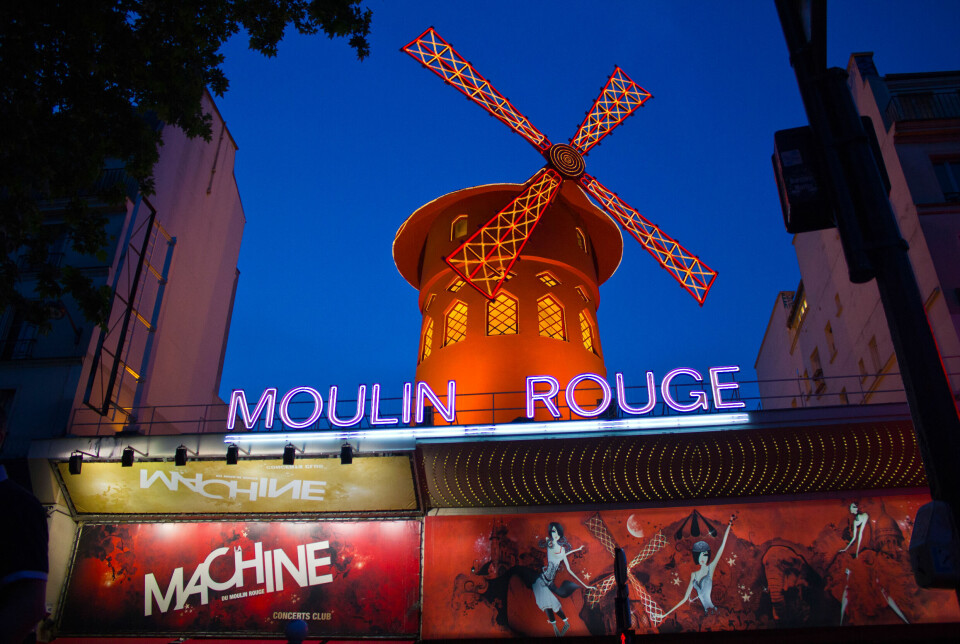Blades of Paris Moulin Rouge cabaret club mysteriously fall off
It was not a windy night and the blades are checked regularly, say managers
A view of the Moulin Rouge windmill with its iconic blades
Jonathan Weiss / Alamy Stock Photo
The blades of the iconic Moulin Rouge cabaret windmill mysteriously fell off last night - along with the first three letters of the word ‘Moulin’.
The incident happened at around 01:45. No-one was injured.
“There was no-one on the pavement, and we are very relieved that there were no victims,” said an employee of the Moulin Rouge and its director general, Jean-Victor Clerico, to FranceInfo.
Police intervened and cordoned off the area at around 02:45, and a security perimeter is in place in case of any further damage.
An employee in a nearby hotel, who heard the incident, said: “I heard a big glass noise, as if someone was throwing a bag full of bottles from a third-floor window.”
The second show at the cabaret hall - which 850 people attended - had finished by the time the incident happened.
The cause is still unclear but police say they do not suspect a malicious act.
Managers have said that the iconic blades - which were replaced entirely 20 years ago - are checked every two months to ensure that the mechanism is working properly, and the cabaret's technical director also checks it "every week". No anomaly or technical issues had been reported recently, said Mr Clerico.
Police suggested that "the weather conditions" and "possible dilapidation" could have contributed to the incident, but Mr Clerico has disputed this.
"Last night, there were no gusts of wind,” he said. “The wings cannot freewheel; they are powered solely by an engine.”
The blades were winched onto a van and taken away, covered by a tarpaulin, this morning. The first three letters of ‘Moulin’ - which were ripped off as the wings fell - are still missing.
The scheduled shows will still take place this evening as the building itself is not damaged, managers said.
In a tweet on X, Culture Minister Rachida Dati wrote: “One of the world-famous symbols of Paris, lost its sails last night. It's an emotional night for the world of show business and for all lovers of Paris.”
She said that “protecting and restoring our heritage is one of [her] priorities” and that her ministry “is standing by the Moulin Rouge to ensure that its special splendour is restored”.
Why does the Moulin Rouge have a ‘moulin’ (windmill)?
The Moulin Rouge (‘Red Windmill’) is located on Boulevard de Clichy in the 18th arrondissement of Paris, at the foot of the Butte of Montmartre. Its 'Pigalle' cabaret was founded in 1889 and celebrated its 135th anniversary in 2024.
The story usually goes that co-founder Josep Oller built a windmill on the club as a nod to a time when Montmartre was a small wheat-milling village with several of its own windmills.
However, another version claims that Mr Oller built the red windmill as a tribute to three brothers of the Debray family, who were killed defending their bread flour mill from the Cossacks. One of the brothers was reportedly ‘nailed to the cross’ of his own windmill.
After they died, in 1833 another Debray brother stopped milling, and instead opened a wine and dancing bar in the area. It was called Le Moulin de la Galette, after a type of bread made with the brothers’ milled flour, and was a ‘guinguette’ - an outdoor bar that sold cheap wine.
The guinguette (the word itself comes from a type of sour white wine) became popular and is the subject of paintings by iconic contemporary artists including Pierre-Auguste Renoir and Vincent Van Gogh.
The three murdered Debray brothers are buried in the Cimetière de Montmartre, and the red colour of the Moulin Rouge is said to symbolise their blood. However, others say the red colour is also a sly nod to the ‘world’s oldest profession’.
Now, more than 600,000 people visit every year to see the infamous ‘French Cancan’ dancers. The club was also depicted in technicolour in the 2001 tragi-comic film Moulin Rouge, directed by Baz Luhrmann and starring Nicole Kidman and Ewan McGregor.





























